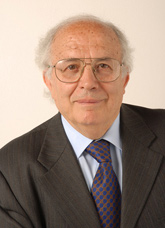Gerardo Bianco
Gerardo Bianco | |
|---|---|
 | |
| Minister of Education | |
| In office 27 July 1990 – 13 April 1991 | |
| Preceded by | Sergio Mattarella |
| Succeeded by | Riccardo Misasi |
| President of the Italian People's Party | |
| In office 12 January 1997 – 2 October 1999 | |
| Preceded by | Giovanni Bianchi |
| Succeeded by | Office abolished |
| Secretary of the Italian People's Party | |
| In office 1 July 1995 – 12 January 1997 | |
| Preceded by | Rocco Buttiglione |
| Succeeded by | Franco Marini |
| Member of the Chamber of Deputies | |
| In office 30 May 2001 – 28 April 2008 | |
| Constituency | Campania |
| In office 5 June 1968 – 14 April 1994 | |
| Constituency | Benevento–Avellino–Salerno |
| Personal details | |
| Born | 12 September 1931 Guardia Lombardi, Italy |
| Died | 1 December 2022 (aged 91) Rome, Italy |
| Political party | DC (until 1994) PPI (1994–2002) Independent (2002–2004) IP (2004–2008) The Rose for Italy (2008) |
| Height | 1.69 m (5 ft 7 in) |
| Relations | Lucio Bianco (brother) |
| Profession | Politician, university professor |
Gerardo Bianco (12 September 1931 – 1 December 2022) was an Italian politician.[1]
Early life
[edit]Bianco was born in Guardia Lombardi, Campania in Italy.[2] Winner of a scholarship at the Augustinianum College of Catholic University of the Sacred Heart, he graduated in classical letters.[citation needed]
Career
[edit]Bianco has been Deputy from 1968 to 1994 and from 2001 to 2008, chairman of Christian Democracy (Democrazia Cristiana; DC) in the Chamber from 1979 to 1983 and from 1992 to 1994, Vice-President of Chamber of Deputies from 1987 to 1990 and MEP from 1994 to 1999. He also served as Minister of Education in the Andreotti VI Cabinet.
In 1995 he opposed the Secretary of the Italian People's Party (PPI), Rocco Buttiglione, for his approach to the centre-right during the regional elections that year. Bianco was subsequently elected Secretary of the PPI while Buttiglione founded a new party, the United Christian Democrats (CDU). He remained Secretary until 1997, the year he became president of PPI. He also was the director of the newspaper Il Popolo in 1995 and from 1999 to 2000.
In 2002 Bianco opposed the dissolution of the PPI into The Daisy (DL), and so joined the new party as an independent. In 2004 he founded the movement Popular Italy(IP), with the purpose of restoring an autonomous organized presence for democratic Catholics in Italy.[3] In 2008 he refused to join the Democratic Party (PD) and instead entered the mixed (Misto) group.
Personal life and death
[edit]Bianco died in Rome on 1 December 2022, at the age of 91.[4]
References
[edit]- ^ Stella e gli ex famosi Gerardo Bianco, ai giardinetti mai
- ^ "Bianco". Associazione per lo sviluppo dell'industria nel Mezzogiorno (in Italian). Archived from the original on 30 December 2017. Retrieved 29 December 2017.
- ^ Nasce il movimento “Italia popolare”. Luogo politico di ascolto del cattolicesimo democratico[permanent dead link]
- ^ "Bianco, storico esponente della Dc. Mattarella: "Leale servitore delle istituzioni"". La Repubblica. 1 December 2022. Retrieved 1 December 2022.
External links
[edit] Media related to Gerardo Bianco at Wikimedia Commons
Media related to Gerardo Bianco at Wikimedia Commons
- 1931 births
- 2022 deaths
- Christian Democracy (Italy) politicians
- Democracy is Freedom – The Daisy politicians
- Italian People's Party (1994) politicians
- Democratic Party (Italy) politicians
- Deputies of Legislature V of Italy
- Deputies of Legislature VI of Italy
- Deputies of Legislature VII of Italy
- Deputies of Legislature VIII of Italy
- Deputies of Legislature IX of Italy
- Deputies of Legislature X of Italy
- Deputies of Legislature XI of Italy
- Deputies of Legislature XIV of Italy
- Deputies of Legislature XV of Italy
- MEPs for Italy 1994–1999
- University of Parma alumni
- Academic staff of the University of Parma
- Italian Roman Catholics
- People from Guardia Lombardi
